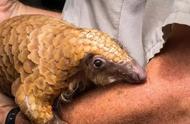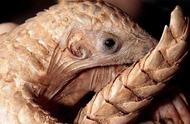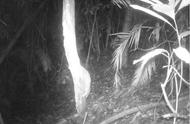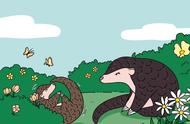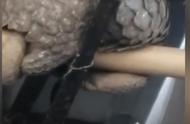The pangolins, or scaly anteaters, are classified as mammals (Order Pholidota). Nevertheless, the back, upper flanks, and the outer surfaces of a pangolin's legs are covered with large scales similar in shape to the armor plates of a stegosaurid. Several different kinds of pangolins are extant. A Giant Pangolin (Smutsia gigantes) is pictured in Figure 9.2. In the figure, note that although only a portion of each scale shows (because each is mostly covered by the ones that overlap it), the scales of a pangolin are actually about as large in proportion to body size as are a stegosaurid's armor plates. A pangolin's scales are attached to the skin, not the skeleton and can bristle because they are attached only at one end. For this reason, one would not expect them to remain in place in a fossilized animal. They would detach after death as the skin decomposed. Known stegosaurid remains are so severely disarticulated that it is not even certain how many scales they had. The supposed tail spikes of stegosaurids are about as large in proportion to body size as are the huge claws of a pangolin (see Figure 9.2). In stegosaurids, also, these spikes (claws?) may well have been attached to the feet, and not the tail.

Figure 9.2 Main figure: Giant Pangolin (Smutsia gigantes). Inset: A typical reconstruction of the familiarStegosaurus. Note that the shape of the pangolin's scales, and their size in proportion to body size, are like those of the animal shown in the inset (in a pangolin's armor about half of each scale is hidden by overlap). Observe, too, on the pangolin's feet, the presence of large claws that, in reconstructions of supposed stegosaurids, have perhaps been misinterpreted as tail spikes (see text).

The overall form of a pangolin, too, is similar to that of a stegosaurid — a long thick tail, highest point at hips, nose to ground. The proportion of the limbs is also similar. A pangolin's skull, which bears little resemblance to that of other living mammals, is quite similar to that of a stegosaurid.¹² Pangolins have no teeth.¹³ Even in large stegosaurids, the jaws are weak and the teeth are tiny and ineffectual. Stegosaurids apparently used gizzards to grind their food.¹⁴ The presence of a gizzard is not usually considered a mammalian trait, but pangolins do possess this organ.¹⁵ Giant armadillos and most types of pangolins share a similar lifestyle. Most are nocturnal, burrowing forms. According to Walker (1983), the diet of the giant armadillo
consists primarily of termites, but ants, other insects, spiders, worms, larvae, snakes and carrion are also consumed.
Pangolins also feast on such fare. Both armadillos and pangolins use their heavy claws to rip into termite mounds, anthills, and carcasses and then, with their long, protrusible tongues, lap up their dinners.¹⁶
Various types of pangolins exist, distributed over much of the tropical world, from West Africa to Borneo.¹⁷ Fossil forms are known, too, from North America.¹⁸ Fossils recognized as pangolins date to as early as the Paleocene,¹⁹ just after stegosaurids supposedly went extinct.²⁰ The largest living pangolin is about two meters long,²¹ the smallest known stegosaurid (Kentrosaurus), measures about two and a half meters.²²,²³ Similarly, the length of the largest extant armadillo is about two meters,²⁴ while the smallest ankylosaur known (Struthiosaurus) measured two meters.²⁵ As has already been mentioned, huge armadillos, probably exterminated by humans, survived in South America until a few thousand years ago.
The modern giant armadillo is so similar to the ancient ankylosaurs that it is only reasonable to suppose it is descended from them. The same is true for pangolins and stegosaurids (although the case is somewhat weaker because the exact external form of stegosaurids is a point in dispute). These similarities strongly suggest that two of the most common "dinosaurs" of the so-called Age of Reptiles — ankylosaurs and stegosaurids — were in fact mammals, and, even more remarkably, that their direct descendants exist even today. So in their cases, it seems, there was no "extinction of the dinosaurs" — there was merely a reconceptualization and reclassification (both may be cases of residual dwarfism). If so, then the diet of stegosaurs and ankylosaurs was probably not herbaceous, as has been conjectured. The diets of their modern counterparts would suggest that they were primarily insectivores that also ate small vertebrates and carrion. Their jaws completely lack the grinding teeth needed to process tough plant material. They probably used darting tongues to feed on insects and small vertebrates then ground them in a gizzard.

The apparent mammalian status of stegosaurs and ankylosaurs seems also to contradict the idea that Cretaceous mammals were small (since many forms in these two categories were huge animals). Moreover, if the ankylosaurs and stegosaurids were placental mammals, as are their apparent modern counterparts, then the placental mode of reproduction must date to a far earlier date (at least to the early Jurassic) than that generally proposed in the mammalian radiation dogma, according to which the first placentals appeared in the late Cretaceous (about a hundred million years later). Such findings raise the suspicion that at least some of the other members of Ornithischia, the "reptilian" order containing ankylosaurs and pangolins, may turn out to be mammals, too, since the bony structure of other ornithischians is similar to that of ankylosaurs and stegosaurids.
Nevertheless, accepted theory says simply that armadillos and pangolins evolved from "small, primitive, generalized" placental mammals living late in the Cretaceous, and that they have nothing whatever to do with dinosaurs. Presumably a neo-Darwinian would account for the near identical appearance of modern giant armadillos and ancient ankylosaurs by ascribing it to "adaptation to similar niches." This is implausible — armadillos appear in the fossil record right after "ankylosaurs" supposedly went extinct. The only clear distinction between the two is that the fossil animals we call ankylosaurs lived in the "Age of Reptiles," while the ones we call armadillos lived in the "Age of Mammals."
It may be this tendency to categorize on the basis of time simply reflects a lingering bias among biologists. Some attention has already been givento the influence of the scala naturae on biological thought. In its classical conception, the scala was simply a static ordering of beings, from "lowest" to "highest." Early evolutionary thinkers temporalized this concept by asserting that "lower" biological forms arose at an earlier date, and "higher" ones arose at a later date. Thus, the relative positions of the various animal forms in the old, static hierarchy gave rise to a particular temporal ordering of the story told about evolution. Briefly, this story said the order of appearance was (1) invertebrates, (2) fish, (3) amphibians, (4) reptiles, (5) birds, and (6) mammals.
Even today, this viewpoint seems to contribute to habits of thought that tend to bias the way scientists talk about fossils. In particular, the idea that mammals are "higher" and that they came after reptiles seems to dispose paleontologists to call very similar animals (e.g., ankylosaurs and giant armadillos) by different names and to make very different claims about their natures (i.e., that one is a reptile and the other a mammal). Another example is seen in the ease with which biologists accept the idea that synapsids were reptiles. If synapsids were classified as early mammals (as might seem reasonable on the basis of their hard anatomy), the earliest known mammals would then be the contemporaries of the earliest known reptiles.
原文链接:
http://www.macroevolution.net/pangolins.html

